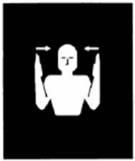Use the following format to cite this article:
Use of hand signals in production agriculture. (2012) Agricultural Safety and Health eXtension Community of Practice. Retrieved from https://ag-safety.extension.org/use-of-hand-signals-in-production-agriculture/.
Hand signals are an important means of communication on farms and ranches when noise levels are too loud or the distance is too far between workers to effectively use verbal communication. The American Society of Agricultural Engineers (ASAE) developed a standardized set of 11 hand signals for use in production agriculture to enhance communication and promote safety (ASABE, 2011). With the exception of one hand signal, all of the signals can be completed with the use of one arm.
Hand signals can be used to effectively communicate instructions, save time, and lower the risk of an injury or death. As a farmer or rancher, you need to understand the hand signals and teach the hand signals to those involved in your operation. The ASAE hand signals are shown below:
This far to go (ASAE Figure 1)

Place palms at ear level facing your head and move inward to show the remaining distance to go.
Come to me (ASAE Figure 2)

Raise your arm vertically over your head, palm out to the front, and rotate in large horizontal circles.
Move toward me (ASAE Figure 3)

Point toward the person, vehicle, or unit. Signal by holding arm horizontally to the front, palm up, and motiong toward the body.
Move out (ASAE Figure 4)

Face the desired direction of movement; hold the arm extended to the rear: then swing the arm overhead and forward in the direction of desired movement until the arm is horizontal with palm down.
Stop (ASAE Figure 5)

Raise the hand upward to the full extent of the arm, palm to the front. Hold that position until the signal is understood.
Increase speed (ASAE Figure 6)

Raise the hand to the shoulder, fist closed; thrust the fist upward to the full extent of the arm and back to the shoulder rapidly several times.
Decrease speed (ASAE Figure 7)

Extend arm horizontally sideward with palm down; wave arm downward at 45 degrees minimum several times. Do not move your arm above horizontal.
Start the engine (ASAE Figure 8)

Move arm in circular motion at waist level to simulate cranking engine.
Stop the engine (ASAE Figure 9)

Draw right hand, palm down, across your neck in a “throat-cutting” motion left to right.
Lower equipment (ASAE Figure 10)

Use circular motion with either hand pointing to the ground.
Raise equipment (ASAE Figure 11)

Make circular motion with either hand at head level.
Resources:
Click HERE for on Hazardous Occupations Safety Training in Agriculture (HOSTA) Task Sheet 2.9 to see diagrams and examples of when to use each of the hand signals.
Use the following format to cite this article:
Use of hand signals in production agriculture. (2012)Agricultural Safety and Health eXtension Community of Practice. Retrieved from https://ag-safety.extension.org/use-of-hand-signals-in-production-agriculture/.
Sources
American Society of Agricultural and Biological Engineers (ASABE). 2011. ANSI/ASAE S351 FEB1972 (R2007), Hand Signals for Use in Agriculture. ASABE Standards 2011. St. Joseph, MI: ASABE.
National safe tractor and machinery operation program: Student manual revised third edition. (2020) Penn State Extension. Not available online.
Johnson, S. & Murphy, D. (2008) Agricultural hand signals. Pennsylvania State University College of Agricultural Sciences Cooperative Extension. Retrieved from http://extension.psu.edu/business/ag-safety/vehicles-and-machinery/gener….
